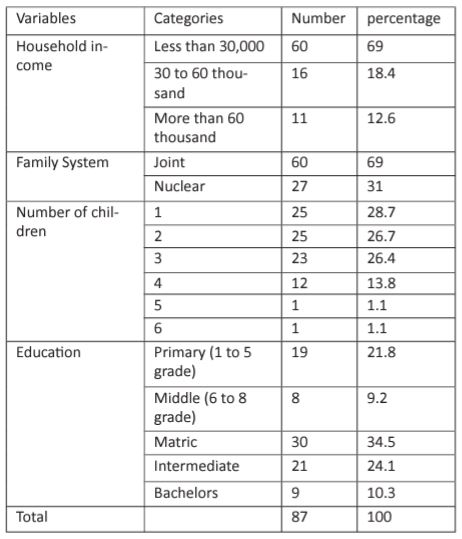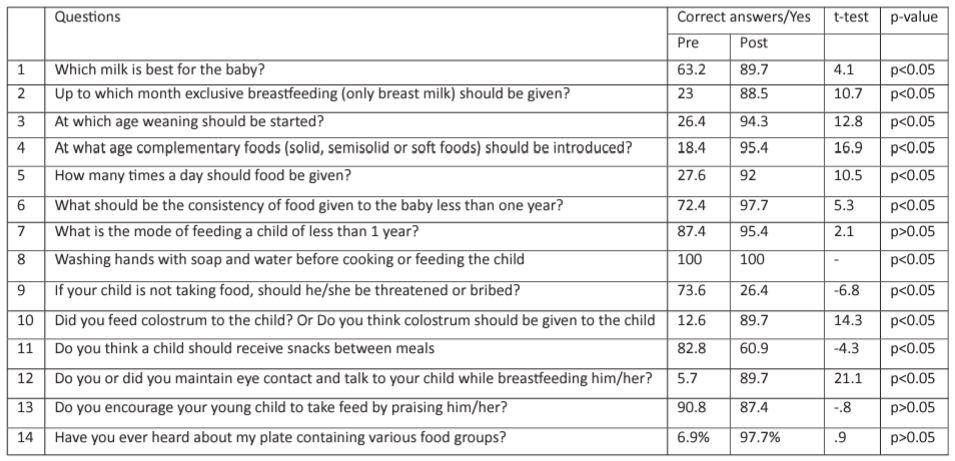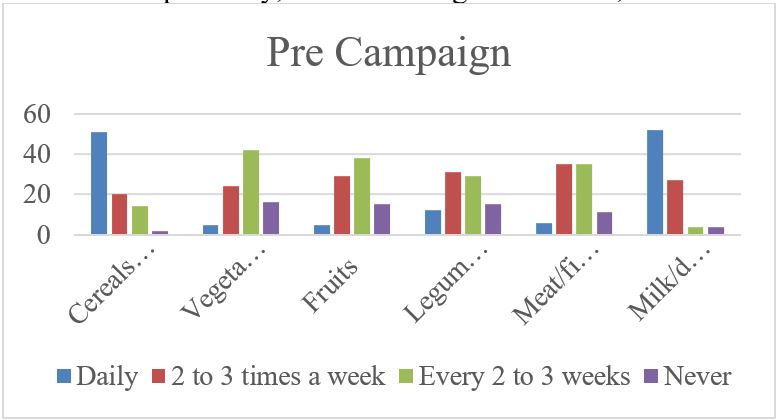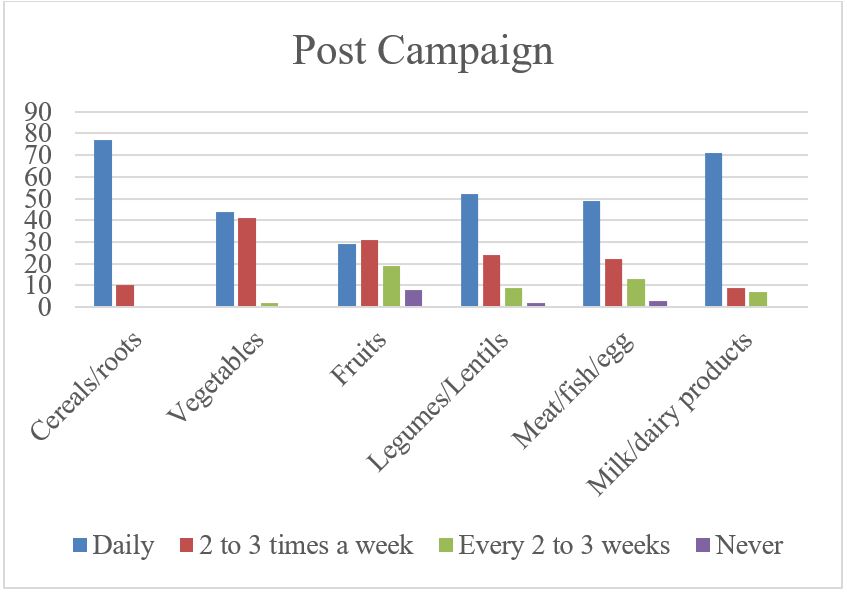Review article - Volume 3 - Issue 6
Effect of dietary diversity awareness campaign on feeding practices of mothers of children aged under 5 years in district Mirpur, AJK; A Quasiexperimental study
Hina Shafi1*; Shahzad Ali Khan2; Jamil Ahmad3; Abrar Hussain Azad4; Momina Habib5; Muhammad Arslan Shafi6; Sundus Shafi7; Shaaray Abrar Umar8
1Demonstrator Community Medicine, Mohi-Ud-Din Islamic Medical College, Mirpur, Azad Kashmir, Pakistan.
2Vice Chancellor Health Services Academy, Islamabad, Pakistan.
3Pediatric Registrar Maroof National Hospital, Mirpur Azad Kashmir, Pakistan.
4Head of Department Community Medicine, Mohi-Ud-Din Islamic Medical College, Mirpur, Azad Kashmir, Pakistan.
5Rawal General and Dental Hospital Islamabad, Pakistan.
6Ophthalmologist Al-Shifa Eye Trust Hospital Rawalpindi, Pakistan.
7Post Graduate Trainee CMH Kharian Gujrat, Pakistan.
8Post Graduate Trainee CDA Hospital Islamabad Pakistan.
Received Date : Oct 26, 2023
Accepted Date : Nov 16, 2023
Published Date: Nov 23, 2023
Copyright:© Hina Shafi 2023
*Corresponding Author : Hina Shafi, Demonstrator Community Medicine, Mohi-Ud-Din Islamic Medical College, Mirpur, Azad Kashmir, Pakistan.
Email: hinashafi73@gmail.com
DOI: Doi.org/10.55920/2771-019X/1585
Abstract
Background: Dietary diversity is described as the consumption of a variety of food types during a certain period. Increasing the variety of foods and food groups in the diet helps to ensure adequate intake of es-sential nutrients. Diet-related malnutrition affects one out of three individuals globally. Despite economic and social progress, childhood malnutrition remains a major public health and social issue in Pakistan. The current study objective was to see the effects of a dietary diversity awareness campaign on the feeding practices of mothers of children aged under 5 years.
Methodology: A quasi-experimental study design was used for the current study. The study was con-ducted in a rural village Jatlan of District Mirpur Azad Jammu & Kashmir. Mothers with at least one child under the age of 5 years were study participants. A pre-structured questionnaire was used to determine the knowledge and practices related to dietary diversity. Data were collected at the baseline and end-line levels with the help of LHWs. The participants received a one-week awareness campaign of Dietary Diversity (DD) and My Plate.
Results: The study consisted of 87 females, with a median age of 29 years. Before the campaign, 5.7% of participants knew DD and 64.4% had low DD. After the campaign, significant differences were noted in terms of knowledge and feeding practices, and 43.7 participants were noted to have high DD.
Conclusion: The study has highlighted that nutrition education has an impact on maternal knowledge and feeding practices in terms of dietary diversity. Nutrition interventions targeting infants and young children with malnutrition in Pakistan can be fruitful in making individuals aware of better food choices thus con-tributing to better childhood development.
Keywords: Dietary diversity, my plate, malnutrition, feeding practices in under 5 children.
Background
Malnutrition, as shown by stunting and wasting, continues to be a significant issue among young children and newborns. Inadequate nutrition throughout early infancy is a major cause of stunting [1]. Dietary diversity is described as the consumption of a variety of food types during a given period. It represents the idea that increasing the variety of foods and food types in one's diet can assist in ensuring optimal nutrient intake [2]. My Plate icon is "a simple, yet powerful, visual cue to prompt consumers to think about their food choices across food groups and to build a healthy plate at meal times". To that end, My Plate is a component of a multimodal communi-cation strategy that includes the My Plate Web-site with a tool for personalizing food plans, con-sumer educational materials and e-tools, social media engagement, and a partnership initiative to assist in coordinating and disseminating con-sistent messages [3]. Non-diversified diets can hurt individuals' well-being, prosperity, and im-provement, not just by bringing down actual lim-its and contamination opposition, yet in addition by compromising mental turn of events, concep-tive, and, surprisingly, social limits [2].
Dietary diversity plays an important role in en-suring adequate provision of nutrients for a balanced diet, which is essential for children's growth. At a national level, almost 23% of these children are underweight. Over half the children are affected by stunting 38% and about 9% by wasting. Despite economic and social progress, childhood malnutrition remains a major public health and social issue. Data are scarce on the impact of nutrition education on maternal knowledge, and feeding practices in terms of dietary diversity, as a nutrition intervention targeting infants and young children with malnutrition in Pakistan. Assessment and provision of dietary diversity awareness to the caregivers of children is crucial for childhood development. Such cam-paigns can equip caregivers with the knowledge of diverse food choices that can pro-vide the children with an adequate number of micronutrients. This research aims to conduct a one-week dietary diversity campaign with visual material and educational sessions for the mothers of children under 5 years of age.
Child malnutrition in Pakistan is increasing at an alarming rate which calls for the need to ad-dress the root causes of this situation like low dietary diversity. Moreover, the proportion of caregivers who have adequate dietary diversity knowledge is very low in Pakistan. The nutrition provided in early childhood forms the foundation to achieve full genetic potential. There is a need to address this issue so that appropriate health policies can be made.
Methodology
A quasi-experimental study de-sign was used for the current study. The study was conducted in a rural village Jatlan of District Mirpur Azad Jammu & Kashmir. The catchment population of the selected village is large and BHU is at an easily accessible location. Data were collected at the baseline and end-line levels with the help of LHWs. LHWs recruitment was done based on their background knowledge of nutrition and complete information and training about my plate were delivered to LHWs before the start of study conduction. The mothers of children aged under 5 years were given daily dietary diversity sessions for one week. The sessions were 1-2 hours long and they included the presentations on My Plate along with adequate visual educational material. The impact of dietary diversity knowledge was assessed after the session completion by using a food frequency questionnaire that included information on different foods from food groups recommended by WHO. The study was three months long from January 2022 to March 2022. The pre-structured questionnaire was used for the compilation of data. The questionnaire consisted of three sections; section one used the standard questions from the demographic and health survey questionnaire to ascertain the characteristics of respondents. The second section includes questions to determine the knowledge and practices and the third section is comprised of a food frequency table. The study participants recruited were solely the mothers of children aged under 5 years.
A simple random sampling technique was used. The sample size was calculated using a sample size calculator and it was 87. Participants were recruited according to the inclusion and exclusion criteria. Inclusion criteria consist of mothers visiting BHU for immunization and consultation while exclusion criteria were mothers having a nutritional background and having any psychological issues. A pilot study was performed on 20 mothers who were later not enrolled in the study and findings from the pilot group were utilized to modify the questionnaire and intervention technique. For the baseline survey, the questionnaire was used to collect pre-intervention data from LHWs. The group of approx. 100 mothers were divided into 5 batches of 20 mothers each. Awareness sessions were conducted for each batch Monday to Friday. The sessions included information and visual representation of the My Plate concept. After the awareness sessions, the post-intervention questionnaire was administered to check if mothers have incorporated dietary diversity knowledge into the child feeding practices.
The filled questionnaire's data after coding was entered in the 23rd version of the Statistical Package for Social Sciences (SPSS 23) to analyze its descriptive and inferential statistics. Socio-demographic parameters were analyzed for frequency and percentages. For inferential statistics, the consumption of food from a particular number of food groups was given codes, and a paired t-test was used to make inferences about the pre-and post-intervention food frequency questionnaire scores.
Results
Socio-demographic: The study con-sisted of 87 females ranging from the minimum age of 20 years to the maximum age of 40 years old. Most of the participants lived in a joint fami-ly system (69%) whereas 27 (31%) resided in a nuclear system family. Twenty-five females had only one child whereas another 25 had 2 chil-dren, 23 of the women had 3 children and 14 women had at least four children. The majority of these families had at least one child who was under the age of five, while the ages of the other children ranged from less than one year to up to ten years old. In terms of educational level ma-jority, 30 (34.5%) had education up to matric level (Table 1).
Knowledge and practices of mothers
The knowledge and practices of mothers were assessed on the questionnaire. Results showed that in terms of breastfed infants, the mothers had an unsatisfactory level of knowledge with the majority giving wrong answers to questions on exclusive breastfeeding and weaning. Questions about food consistency and mode of feeding were correctly answered by the majority of mothers. Inadequate knowledge was also observed with questions on complementary foods, timings at which food should be taken, and snacks for children under 5. Only a few mothers have heard about the concept of My Plate and Dietary Diversity while the rest answered with no and don't know. In terms of feeding practices, all mothers practised hand washing before feeding the child, more than half of the mothers answered that a child should be threatened or bribed if he or she is not taking food. More than half of the women mentioned giving snacks to children in between meals. Very few women (12.6%) practised the feeding of colostrum to the child at the time of birth. Almost all women (5.7%) answered with not maintain eye contact or/and talking with the child while feeding him/her. After the awareness campaign, more correct answers were observed. The questions on breastfeeding were answered correctly by most participants (88.5%). The practices and what should be practised questions also (p < 0.05).
Table 1: Demographical Characteristics of Study Population (N=87).

Table 2: Knowledge and Practices of Mothers Pre and Post-Intervention (N=87).

Food groups
The data was sorted and categorized into six major food groups, the consumption of which is demonstrated in the figures below. Before the campaign 58.6% of the participants had a daily intake of cereals/roots, 5.7% had vegetables and fruits respectively, 13.8% had legumes/lentils, 6.9%had Meat/ fish/egg and 59.8% had Milk/ dairy products. After the campaign, 77 (88.5%) participants had a daily intake of cereals/roots, 44 (50/6%) had vegetables, 29 (33.3%) had fruits, legumes/lentils intake was 52 (59.8%), Meat/fish/ eggs were taken by 49 (56.3%) and Milk/dairy products at 71 (81.6%). A significant correlation was found between the consumption of food groups before and after the awareness program (p<0.05).
Dietary diversity
The participants were asked about the food they feed to children in their everyday routine. The most frequent foods taken from cereal and milk (and dairy products) groups. Whereas lentils and fruits were among the least used food groups. Dietary Diversity was divided into 3 categories low, medium, and high based on the usage of different food group elements. Socio-demographics including age, education, family type, and education status of participants were compared with dietary

Figure 1: Pre-campaign food groups consumption (N=87).
Table 3: Dietary Diversity scores pre and post-intervention (N=87).

diversity scores. However, there was no significant association between dietary diversity scores and socio-demographic features (p>0.05).

Figure 2: Post-campaign food groups consumption (n=87).
Discussion
The assessment and provision of dietary diversity awareness to the caregivers of children is crucial for childhood development. Such campaigns can equip caregivers with the knowledge of diverse food choices that can provide the children with an adequate number of micronutrients. Literature evidence indicates that dietary diversity plays an important role in ensuring adequate provision of nutrients for a balanced diet which is essential for children's growth. A balanced diet also enhances the chances of being better built and in countries such as Pakistan where there is a high frequency of malnourished children, it is essential to make populations aware. To improve nutritional status more such campaigns are needed relating to dietary diversity.
The study draws on various components of feeding knowledge and practices of mothers. The results have indicated some prominent differences in terms of results practices pre-intervention and post-intervention. This aligns greatly with past explorations that have also seen comparative changes in results before an awareness campaign and after it [6, 7, 8, 9].

Figure 2: Post-campaign food groups consumption (n=87).
The results of the current study show that the intake of different food groups such as vegetables was limited and a more prominent intake of cereals was observed. This aligns with Burkina's research on a similar topic where the supplementary dietary diversity was minimal and restricted to cereals among young children [10-15].
Before the campaign, it was observed that fewer food groups were utilized by the participants to feed the children. It was also observed that processed food such as biscuits, cookies, and sweets was taken almost every day in the studies, this correlates with previous evidence which highlighted that a significant proportion of study participants ingested less healthy foods. Also, literature has indicated that grains were used most instead of healthier options this was again similar to the results that this current study observed [6-23].
The study participants were not aware of concepts such as My Plate, however, after the demonstration, the results varied and the mothers who previously had little to no knowledge about such topics acquired good knowledge. This has also been demonstrated in previous evidence and thoroughly conveying information gives fruitful results [4, 24 -25].
Conclusion
Poor dietary quality, quantity, and inappropriate feeding practices can lead to poor nutritional status. To make the community aware of the correct feeding practices a diet diversity awareness program was introduced with this research. Health promotion is an important subject of public health and malnutrition is a major public health concern, so it was important to carry out such a study. The study has highlighted that nutrition education has an impact on maternal knowledge and feeding practices in terms of dietary diversity. The intervention has shown positive results in terms of food consumption before and after the program. Nutrition interventions targeting infants and young children with malnutrition in Pakistan can be fruitful in making individuals aware of better food choices thus contributing to better childhood development.
References
- Stewart CP, Iannotti L, Dewey KG, Michaelsen KF, Onyango AW. Contextualising complementary feeding in a broader framework for stunting prevention. Matern Child Nutr [Internet]. 2013; 9 Suppl 2(Suppl 2): 27-45. Available from: https: //pubmed.ncbi.nlm.nih.gov/24074316/
- Mukherjee A, Paul S, Saha I, Som T, Ghose G. Dietary diversity and its determinants: A community-based study among adult population of Durgapur, West Bengal. Med J Dr DY Patil Vidyapeeth. 2018; 296-301.
- Levine E, Abbatangelo-Gray J, Mobley AR, McLaughlin GR, Herzog J. Evaluating My Plate: An Expanded framework using traditional and nontraditional metrics for assessing health communication campaigns. J Nutr Educ Behav. 2012; 44(4): S2-12.
- Azadbakht L, Esmaillzadeh A. Dietary diversity score is related to obesity and abdominal adiposity among Iranian female youth. Public Health Nutr [Internet]. 2011; 14(1): 62-9. Available from: https: //pubmed.ncbi.nlm.nih.gov/20353617/
- Arimond M, Ruel MT. Dietary diversity is associated with child nutritional status: evidence from 11 demographic and health surveys. J Nutr [Internet]. 2004; 134(10): 2579-85. Available from: https: //pubmed.ncbi.nlm.nih.gov/15465751/
- Saksvig BI, Gittelsohn J, Harris SB, Hanley AJG, Valente TW, Zinman B. A Pilot School-Based Healthy Eating and Physical Activity Intervention Improves Diet, Food Knowledge, and Self-Efficacy for Native Canadian Children. J Nutr [Internet]. 2005; 135(10): 2392-8. Available from: https: //academic.oup.com/jn/article/135/10/ 2392/4669851
- Başkale H, Bahar Z. Outcomes of nutrition knowledge and healthy food choices in 5- to 6-year-old children who received a nutrition intervention based on Piaget’s theory. J Spec Pediatr Nurs. 2011; 16(4): 263-79.
- Uruakpa FO, Moeckly BG, Fulford LD, Hollister MN, Kim S. Awareness and use of MyPlate guidelines in making food choices. Procedia Food Sci [Internet]. 2013; 2: 180-6. Available from: http: //dx.doi.org/10.1016/j.profoo.2013.04.026
- Moitra P, Madan J, Verma P. Impact of a behaviorally focused nutrition education intervention on attitudes and practices related to eating habits and activity levels in Indian adolescents. Public Health Nutr [Internet]. 2021; 24(9): 2715-26. Available from: https: //www.cambridge.org/core/journals/public-health-nutrition/article/ abs/impact-of-a-behaviourally-focused-nutrition-education-intervention-on-attitudes-and-practices-related-to-eating- habits-and-activity-levels-in-Indian-adolescents/
- Rah JH, Akhter N, Semba RD, Pee S de, Bloem MW, Campbell AA, et al. Low dietary diversity is a predictor of child stunting in rural Bangladesh. Eur J Clin Nutr 2010 6412 [Internet]. 2010; 64(12): 1393-8. Available from: https: //www.nature.com/articles/ejcn2010171
- Nakamoto M, Yun Y, Omine M, Mori S, Shuto E, Nakamoto A, et al. Dietary diversity and characteristics of lifestyle and awareness of health in Japanese workers : a cross-sectional study. J Med Investig. 2020; 67(34): 255-64.
- Levine E, Abbatangelo-Gray J, Mobley AR, McLaughlin GR, Herzog J. Evaluating My Plate: An Expanded framework using traditional and nontraditional metrics for assessing health communication campaigns. J Nutr Educ Behav. 2012; 44(4): S2-12.
- Gavin ML. MyPlate Food Guide. [Internet]. 2018 January 1 [cited 2021 Dec 31]. Available from: https: //kidshealth.org/en/parents/myplate.html
- Black RE, Victora CG, Walker SP, Bhutta ZA, Christian P, de Onis M, Ezzati M, Grantham-McGregor S, Katz J, Martorell R, Uauy R. Maternal and child undernutrition and overweight in low-income and middle-income countries. Lancet. 2013; 382(9890): 427-51.
- Ruel MT, Alderman H. Nutrition-sensitive interventions and programmes: How can they help to accelerate progress in improving maternal and child nutrition? Lancet. 2013; 382: 536-51.
- Pinstrup-Andersen P. Can agriculture meet future nutrition challenges? Eur J of Devel Res. 2013; 25: 5-12.
- Isaacs KB, Snapp SS, Chung K, Waldman KB. Assessing the value of diverse cropping systems under a new agricultural policy environment in Rwanda. Food Sec. 2016; 8(3): 491-506.
- Powell B, Thilsted S, Ickowitz A, Termote C, Sunderland T, Herforth A. Improving diets with wild and cultivated biodiversity from across the landscape. Food Sec. 2015; 7(3): 535-54.
- Lander R, Enkhjargal TS, Batjargal J, Bolormaa N, Enkhmyagmar D, Tserendolgor U, et al. Poor dietary quality of complementary foods is associated with multiple micronutrient deficiencies during early childhood in Mongolia. Public Health Nutr. 2010; 13(9): 1304-13.
- Sawadogo SP, Yves M-P, Claire M-R, Alain B, Alfred TS, Serge T, et al. Late introduction and poor diversity were the main weaknesses of complementary foods in a cohort study in rural Burkina Faso. Nutrition. 2010; 26(7-8): 746-52.
- Romulus-Nieuwelink JJC, Doak C, Albernaz laine, Victora CG, Haisma H. Breast milk and complementary food intake in Brazilian infants according to socio-economic position. Int J Pediatr Obes. 2011; 6(sup3): e508-514.
- Saksvig BI, Gittelsohn J, Harris SB, Hanley AJG, Valente TW, Zinman B. A Pilot School-Based Healthy Eating and Physical Activity Intervention Improves Diet, Food Knowledge, and Self-Efficacy for Native Canadian Children. J Nutr [Internet]. 2005; 135(10): 2392-8. Available from: https: //academic.oup.com/jn/article/135/10/ 2392/4669851
- Başkale H, Bahar Z. Outcomes of nutrition knowledge and healthy food choices in 5- to 6-year-old children who received a nutrition intervention based on Piaget’s theory. J Spec Pediatr Nurs. 2011; 16(4): 263-79.
- Jayawardena R, Byrne NM, Soares MJ, Katulanda P, Yadav B, Hills AP. High dietary diversity is associated with obesity in Sri Lankan adults: an evaluation of three dietary scores. BMC Public Health [Internet]. 2013; 13(1). Available from: https: //pubmed.ncbi.nlm.nih.gov/23566236/
- Locks LM, Pandey PR, Osei AK, Spiro DS, Adhikari DP, Haselow NJ, et al. Using formative research to design a context‐specific behaviour change strategy to improve infant and young child feeding practices and nutrition in Nepal. Matern Child Nutr. 2015; 11(4): 882-96.

